This document introduces attractive, easy-to-keep, local, non-endangered, aquatic pets—the diving beetles. Predaceous diving beetles are aesthetically pleasing yet still rare in aquariums (though common in countries like Japan), which makes them a new, unusual pet. This fact sheet provides information about the aquatic beetles, how to catch them, and how to maintain them. They will bring to your home a mysterious green and quiet world, beautiful silver air bubbles and bronze iridescence, and exciting shows of feeding frenzy. And if you have to part with them, you can safely release the native species into the wild, because they are a part of our nature.
What are Predaceous Diving Beetles?
Aquatic beetles in the beetle family Dytiscidae are known as predaceous diving beetles. Appropriately named, the beetles have many specialized traits that allow them to live and dive underwater. All have a smooth, oval shape with strong, paddle-like hind legs that propel them easily in water. Large eyes with two distinct focal planes similar to bifocal glasses allow them to find water bodies during migration (yes, diving beetles fly!). A large bubble of air under the beetle wing covers (elytra) allows them to suck in a bubble of air from the water surface, as well as breathe underwater for long periods of time without coming to the surface (Flynn 2008). These adaptations are just part of what make the beetles entertaining pets in aquariums. Most importantly, diving beetles are beautiful, dynamic, and interesting, and they need only minimal care!

Credit: Craig Bateman
Where to Collect the Beetles in Nature
There are about 4,000 species of predaceous diving beetles, and they are found on all continents except Antarctica (Nilsson 2001). Diving beetles are common in freshwater and are especially active in warm, humid seasons and climates. Common collecting methods include netting, light trapping, and underwater bottle-trapping.
Light trapping is probably the least effective method for collecting diving beetles, but it does occasionally work. One way entomologists trap insects at night is by hanging a white sheet in front of a light and collecting the insects that fly to the sheet (see http://mississippientomologicalmuseum.org.msstate.edu/collecting.preparation.methods/Blacklight.traps.htm#.Vij72PmrSHs). Any bright light may attract a diving beetle at night, especially those that are near freshwater, isolated from other lights, and open to a large area.
The best way to collect diving beetles is directly from freshwater. A sturdy, fine-mesh net is best for collecting underwater insects (Figure 2). Diving beetles often rest on the bottoms of ponds and marshes, but they may be difficult to locate immediately. A more effective method than netting is trapping. Bottle traps have many advantages, the most important one being that they select for the large, meat-eating species that are good for an aquarium (rather than small, plankton- or insect-eating species). Bottle traps can be constructed using 2-liter soda bottles with the top inverted and secured with staples (Figure 3). Any raw meat can be used as bait. When using the bottle traps, make sure of two things: first, the bottle needs to be checked every day, and all trapped organisms must be removed because insects left in the bottles for prolonged periods will die. Second, there must be an air bubble at the top present at all times, otherwise the beetles will suffocate.
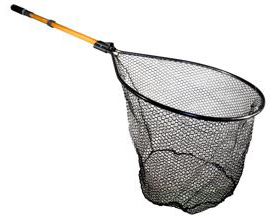
Credit: http://www.istockphoto.com/
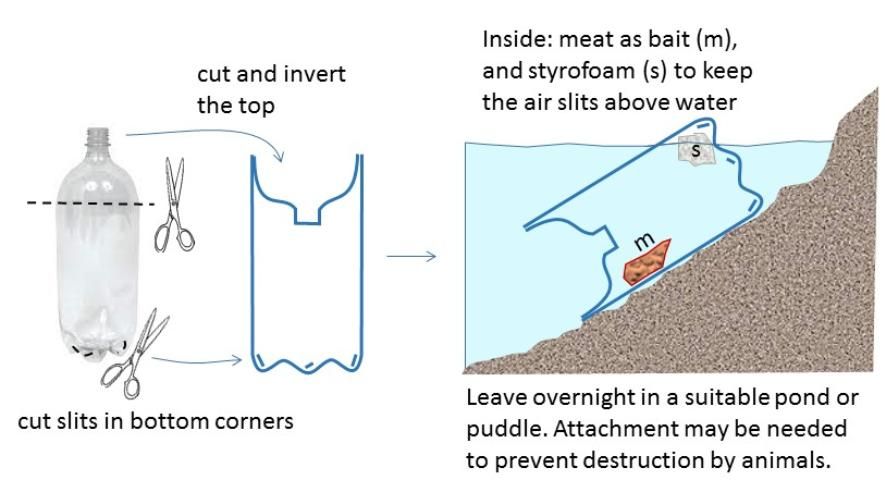
Credit: Jiri Hulcr, UF/IFAS
After collecting, beetles can be transferred in any container to an aquarium. It is a good idea to provide beetles with some aquatic plants or wet tissue paper to grip onto during transport. They should not be transported in water, as they may drown if the water is too splashy and they can't get a proper bubble. If beetles become agitated while handling directly, some species may secrete a milky white substance that is smelly and mildly toxic if ingested. The large species may also bite if provoked, so handle them with care.
Adult beetles can also be purchased online at the website found under the Resources section at the bottom of this article.
Species Suitable for Beginners
There are thousands of diving beetle species in the world. Most of them are small, inconspicuous, and not suitable for in-home keeping. We recommend focusing on the few that are abundant, large, colorful and native to your area (you can check species distributions here: http://bugguide.net/node/view/195). Most diving beetle species have similar captive requirements.
The giant diving beetle (Cybister fimbriolatus) is 2.6–3.3 cm long, and is widespread throughout the United States, mostly in warmer climates. It can be collected in small water bodies without fish, including roadside puddles and cattle tanks. Each beetle can live for several years. They are scavengers, and love earthworms, small pieces of meat, and dead insects. Sometimes they can catch a snail or another living aquatic creature. They are not very good at catching fish, but may succeed at night, so we do not recommend keeping beetles and fish in the same tank.
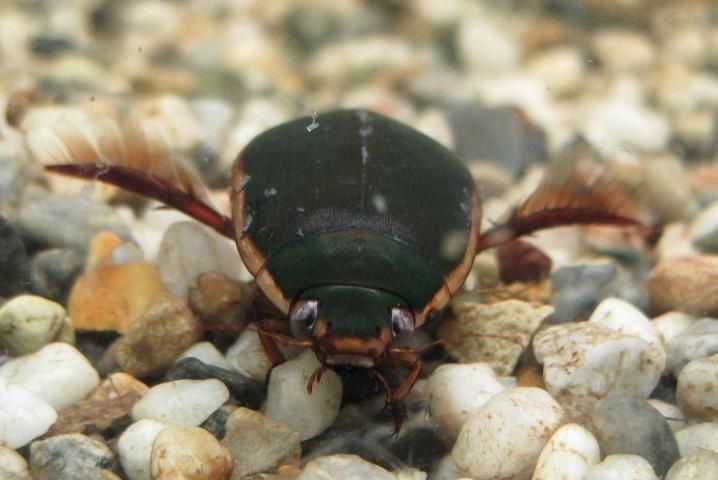
Credit: Jiri Hulcr, UF/IFAS
The sunburst diving beetle (Thermonectus marmoratus) is probably the best species for beginners. It is about 1–1.5 cm long and found in puddles and temporary streams in southwestern North America, even in relatively dry habitats. It is smaller than the giant diving beetle, but it is possibly the most beautiful species in the United States. This species is also exceptionally easy to keep and is active during the day, making it a delight to have in a tank. The sunburst diving beetle will also sometimes produce eggs in captivity that may hatch into larvae. The larvae are mosquito-eating specialists, and raising them to adulthood is not easy (but see Morgan 1992).
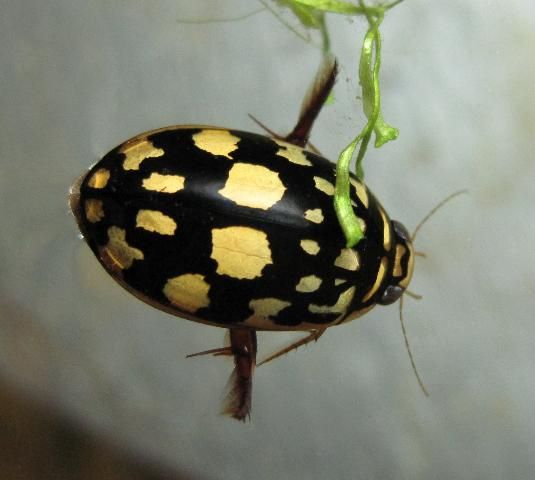
Credit: Jiri Hulcr, UF/IFAS
Various species of Dytiscus are also large, and very beautiful. They can be collected in northern latitudes. Dytiscus spp. are all uncommon, and the only reliable way to collect those is using the diving beetle trap in Figure 3.
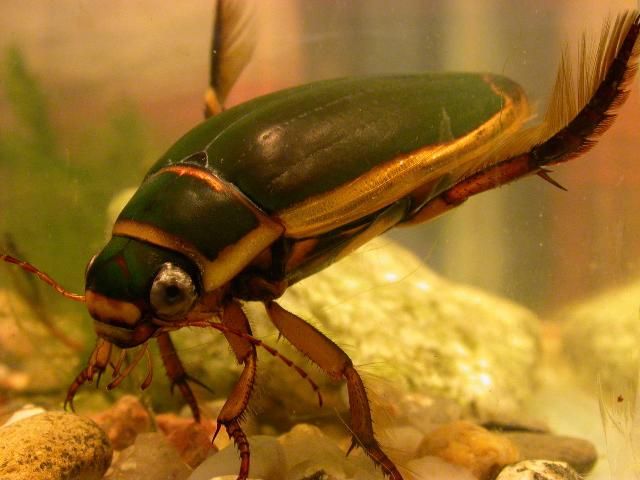
Credit: Jiri Hulcr, UF/IFAS
The Self-Cleaning Diving Beetle Aquarium
Diving beetles are much cleaner than fish. The main reason is that, as invertebrates, they require much less food than fish, and so the input of nutrients in your tank will be significantly lower than if you kept fish. With diving beetles, you can set up your aquarium so that it is essentially a self-cleaning ecosystem. In our experience, the best self-cleaning setup for a diving beetle aquarium is: lots of live aquatic plants, a generous layer of gravel, and no filtration system.
It is all about the balance between algae, plants, and bacteria. Bacteria in the gravel break down excess nutrients and excrement and the plants take up the dissolved nutrients. If you do not have enough bacteria or plants, the tank environment begins to favor algae, which makes the water murky. Your goal is to minimize algae, so you want to maximize plants. And why no filtration system? Not only is it not necessary, but beetles use vibrations in the water to orient themselves, so any filtration systems which agitates the water will create a constant disturbance for them.
This amazing self-cleaning ecosystem is more challenging to accomplish with fish because they are more sensitive to the buildup of waste. Fish consume more food than beetles and produce more waste, creating the need for a filtration system. But with diving beetles, the tank can be very low-maintenance. Beetles are also much less affected by variability in nitrogen or phosphorus concentration because they do not breathe the water like fish do. The beetles are most comfortable in a tangled and quiet aquatic jungle, and it's a lot of fun finding them peeping at you out of their hiding holes and swimming around playfully.
The basic aquarium recommendations are summarized as follows:
-
Water to a depth of ten inches or greater, kept between 10–33°C (50–92°F), but ideally closer to room temperature. Tap water is perfectly adequate (after the chlorine airs out), and the beetles do not have any specific pH requirements like some fish.
-
Underwater surfaces to rest on, such as plants, rocks, or twigs. The more complex the environment, the happier the beetles. In nature they live in the maze of aquatic vegetation, so try to mimic that. The plant that worked best for us is aquatic moss, such as the Java moss available in any aquarium store; it grows bushy and the beetles feel safe in it. It is also dense so it cleans a lot of water. The aquarium will also need sufficient light to keep the plants happy.
-
A cover on the top is very important. The beetles can fly, usually at night, and will escape if the aquarium is not covered. Any screen or plastic cover is fine as long as there is no space for beetles to escape.
-
An above-water surface. The beetles, although aquatic, are still descendants of terrestrial insects, and occasionally need to climb op on land to dry. A piece of floating wood will do, or a rock that reaches above the water. Floating docks commonly used for aquatic turtles may also be used and are available for purchase in most pet stores.
-
No water filtration or aeration equipment is necessary. In fact, beetles prefer perfectly still water.

Credit: Jiri Hulcr, UF/IFAS
Diet and Feeding
In nature, diving beetles are scavenger-predators. They will readily eat a wide range of high-protein foods, living or dead, depending on what is available in their environment (Morgan 1992). Your aquarium set-up will determine how many beetles can be happily supported and how often they need to be fed. Optimal feeding regiments have not been determined, but it is easy for a beetle owner to estimate the need for feeding by observing how voraciously the beetles respond to food.
There has been no real research on the ideal formula for beetle nutrition. But speaking from our experience, a little bit of diversity in food goes a long way to keep your beetles healthy and long-lived. The healthiest and most entertaining foods for diving beetles are fresh invertebrates. What has worked well for us is using frozen blood worms as the staple, and throwing in an occasional bug, meal worm, or earth worm as a snack. Blood worms are larvae of midges (Chironomidae), and are available in most fish stores frozen and prepackaged in cube trays. One beetle will eat a few dozen worms at a time, so you can just remove those from a frozen cube. If you have many beetles, throw in the whole cube every few days and watch the beetles tear it apart! Make sure you are buying blood worms (Chironomidae) and not tubifex worms (Tubificidae). Pet stores sometimes call them both blood worms, but tubifex worms are very fragile and beetles can't really eat them.
As a snack: any bugs you find or catch! Earthworms on the road after rain, flies that you swat in your kitchen, fish food, a tiny piece of raw chicken... Note that the beetles don't really see their food, so after you put food in, you may need to wait for them to find it by smell. Once they do, they go into a feeding frenzy, which is great to watch.
If you can't feed the beetles for a while, it's usually not a problem. Feed them really well so they get their bellies stuffed. After a feast, beetles can go without any food for weeks. Also, the cooler the water, the longer they survive without food, potentially for several months.
Just remember that beetles may eat even those organisms that you would prefer to keep alive, such as fish. Diving beetles may attack fish or other insects, even if they are larger, and eat them. Diving beetles also have a fascinating defense mechanism: they secrete toxic substances that can make vertebrates, such as fish, sick if both are kept in a shared environment (Miller and Mumma 1976).
Reproduction
Most diving beetles will not readily reproduce in a tank. Even if they do, raising the larvae is much more complicated than keeping the adult beetles. It is not covered in this publication.
Resources
Diving beetles are available for purchase here: http://www.bugsofamerica.com/index.html. Additional information about keeping diving beetles is also available on the AquariuMania podcast, episode 53: http://www.petliferadio.com/aquariumaniaep53.html.
Works Cited
Flynn, M. R., and J. W. Bush. 2008. "Underwater breathing: the mechanics of plastron respiration." Journal of Fluid Mechanics, 608, 275–296.
Miller, J. R., and R. O. Mumma. 1976. "Physiological activity of water beetle defensive agents. I. Toxicity and anesthetic activity of steroids and norsesquiterpenes administered in solution to the minnow Pimephales promelas Raf." Journal of Chemical Ecology, 2(2), 115–130.
Morgan, R. C. 1992. Natural History, Captive Management and Display of the Sunburst Diving Beetle Thermonectus marmoratus, AAZPA/CAZPA Annual Conference Proceedings. pp. 457–464
Nilsson, A. N. 2001. World catalogue of insects. Volume 3: Dytiscidae (Coleoptera). Apollo Books.
Stowasser, A., A. Rapaport, J. E. Layne, R. C. Morgan, and E. K. Buschbeck. 2010. "Biological bifocal lenses with image separation." Current Biology, 20(16), 1482–1486.